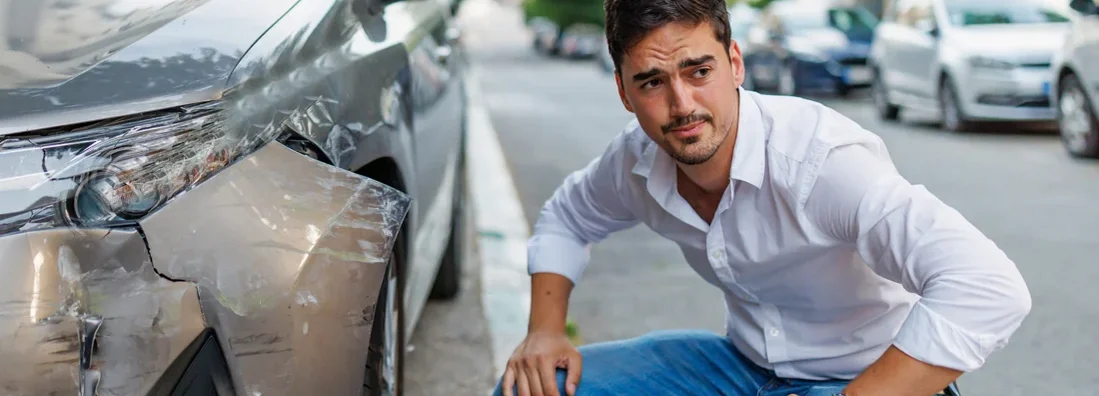What Is Uninsured or Underinsured Motorist Coverage?
Explaining the coverage you need for instances when an at-fault driver doesn't have any or enough car insurance of their own.

Paul Martin is the Director of Education and Development for Myron Steves, one of the largest, most respected insurance wholesalers in the southern U.S.

Nearly 13% of all drivers in the US are currently uninsured. If you get into an accident with another driver who's at fault but doesn't carry any or enough car insurance of their own, you could be stuck covering your own expenses. But if you have uninsured or underinsured motorist coverage, you can still get the reimbursement you deserve in this situation.
An independent insurance agent can help you find all the uninsured or underinsured motorist coverage you need. They'll ensure you get set up with the right car insurance policy. But for starters, here's a breakdown of uninsured and underinsured motorist coverage, what it is, and why you need it.
What Is Uninsured Motorist Coverage?
Uninsured motorist coverage covers your expenses if you end up in an accident with another driver who was at fault but also didn't carry any car insurance of their own. Also, folks often use uninsured motorist coverage after hit-and-run incidents when there's not even an opportunity to ask for the other driver's insurance information.
When would uninsured motorist coverage apply?
If you were the victim of a hit-and-run or an accident with a driver who didn't have car insurance to cover your expenses, uninsured motorist coverage would kick in. Uninsured motorist insurance covers you and any passengers in your car for the following:
- Medical bills
- Lost wages
- Bills related to any pain and suffering
- Physical damage to your vehicle or other property
An independent insurance agent can further explain when you'd need to use uninsured motorist coverage to get compensated.
What Is Underinsured Motorist Coverage?
Underinsured motorist coverage is very similar to uninsured motorist coverage. But underinsured motorist coverage kicks in when the at-fault driver in an accident did have some car insurance of their own but not a high enough amount to fully compensate the other driver for all the bodily injury or property damage they're responsible for.
What’s the Difference between Uninsured and Underinsured Motorist Coverage?
The difference between uninsured motorist coverage and underinsured motorist coverage is pretty much how it sounds. But to break it down further, here's how they’re different:
- Uninsured motorist coverage: When the other driver doesn’t have any coverage at the time of an accident.
- Underinsured motorist coverage: When the other driver has insurance but doesn’t have enough coverage to pay for all the victim's expenses they're responsible for after the accident.
An independent insurance agent can further explain the difference between uninsured and underinsured motorist coverage and which one you might want to add to your policy.
What Are the Two Kinds of Uninsured or Underinsured Car Insurance?
There are two main categories of uninsured and underinsured motorist coverage:
- Uninsured/underinsured motorist bodily injury coverage (UMBI/UIMBI): Even if you have medical payments or personal injury protection coverage, you may still need UMBI/UIMBI coverage to compensate for injuries to yourself or your passengers after an accident with an at-fault driver who doesn't carry any or enough coverage to reimburse you adequately.
- Uninsured/underinsured motorist property damage coverage (UMPD/UIMPD): This coverage can help reimburse you if your car or other property gets damaged by an uninsured or underinsured driver who cannot fully compensate you for the repairs.
These coverages can also sometimes pay for rental cars or the cost of your collision coverage deductible. It depends on your specific policy. Make sure to enlist the help of an independent insurance agent so you can set up your uninsured or underinsured motorist coverage exactly the way you want it.
Is Uninsured or Underinsured Motorist Coverage Required?
Twenty US states and Washington DC currently require uninsured motorist coverage by law.
States where uninsured motorist coverage is required with standard auto policies:

Uninsured motorist coverage in Texas, among many other states, is not required by law. If you live in a state that doesn’t require uninsured motorist coverage, you can still choose to add it to your auto policy.
Do I Need Uninsured or Underinsured Motorist Coverage?
Not only does uninsured or underinsured motorist coverage protect you if you get hit by an uninsured or underinsured driver, but it will also help pay for medical costs, pain and suffering, and lost wages associated with the accident.
In addition, not every state is created equal when it comes to uninsured and underinsured drivers. Some states have more uninsured or underinsured drivers than others, and knowing who you're sharing the road with could sway your decision about whether to add the coverage.
States with the highest percentage of uninsured drivers
| Rank | State | Percent uninsured |
|---|---|---|
| 1 | Florida | 26.7% |
| 2 | Mississippi | 23.7% |
| 3 | New Mexico | 20.8% |
| 4 | Michigan | 20.3% |
| 5 | Tennessee | 20% |
| 6 | Alabama | 18.4% |
| 7 | Washington | 17.4% |
| 8 | Indiana | 16.7% |
| 9 | Arkansas | 16.6% |
| 10 | DC | 15.6% |
| 11 | Alaska | 15.4% |
If you live in one of these areas, it's especially crucial to consider adding uninsured motorist protection to your car insurance policy.
How Much Uninsured or Underinsured Motorist Coverage Do I Need?
If you live in a mandatory uninsured motorist insurance state, your insurer may automatically add the minimum amount to your auto policy. If it’s not required or you want to add to the minimum, it’s recommended to have at least $100,000 per person and $300,000 per accident. An independent insurance agent can help advise you on the exact amount of coverage that's right for you.
What Does Uninsured or Underinsured Motorist Coverage Cover?
Whether you get in an accident with an uninsured or an underinsured driver, uninsured or underinsured motorist coverage will help pay for a number of expenses to get you back on the road. This coverage can pay for the following:
- Property damage repair to your own vehicle
- Other property damage besides your vehicle
- Medical expenses of your family members if they get harmed by an uninsured motorist
- Lost wages and/or lost earning ability
- Nonfinancial costs such as pain and suffering
In most instances, uninsured or underinsured motorist coverage should cover a hit-and-run, but your insurance company will evaluate this on a case-by-case basis.
How Does Uninsured or Underinsured Motorist Coverage Work?
Uninsured or underinsured motorist coverage works by reimbursing you for damages that an at-fault driver can't cover. Suppose you ended up in an accident or hit-and-run with an at-fault driver who fled the scene or wasn't able to reimburse you adequately for their share of the damages. In that case, you'd go through your own car insurance policy's uninsured or underinsured motorist coverage section to recoup the loss.
How Much Does Uninsured or Underinsured Motorist Coverage Cost?
The cost of an uninsured or underinsured motorist policy depends on a number of factors, including your location, age, and the amount of coverage you choose. But average figures for coverage for a 34-year-old married male driver with a $25,000/$50,000 limit policy tend to range between $33 and $76 annually, so coverage is typically highly affordable.
It is important to remember that cost and coverage cannot exceed your auto liability policy. For example, if you purchased $100,000 of bodily injury, $300,000 per accident, and $50,000 property damage coverage, uninsured and underinsured motorists (combined coverage) cannot exceed $100,000/$300,000 for bodily injury.
Do I Need Uninsured or Underinsured Motorist Coverage If I Have Health Insurance?
Yes. Uninsured or underinsured motorist bodily injury coverage can pay you for loss of time at work and medical payments to assist with the deductible. It can also cover services like acupuncture and chiropractor visits that may not be covered under your health insurance plan.
What Is Non-Stacked Uninsured or Underinsured Motorist Coverage?
Non-stacked or unstacked insurance disallows drivers from combining coverage from multiple cars or car insurance policies to increase their total limit of coverage. Non-stacked uninsured or underinsured motorist coverage limits your total coverage limit to that of just the policy for the vehicle involved in the incident. An independent insurance agent can help further explain the differences between non-stacked and stacked uninsured or underinsured motorist coverage.
The Benefits of an Independent Insurance Agent
An independent insurance agent can help you determine the right amount of uninsured or underinsured motorist coverage and will walk you through a handpicked selection of the best policy options for you. Not only that, they’ll cut the jargon and clarify the fine print so you know exactly what you’re getting when it comes to car insurance and uninsured or underinsured motorist coverage or anything else.
https://www.iii.org/fact-statistic/facts-statistics-uninsured-motorists
https://www.nerdwallet.com/article/insurance/uninsured-motorist-coverage
https://www.valuepenguin.com/uninsured-underinsured-motorist-coverage-car-insurance
https://www.insurancebusinessmag.com/us/guides/revealed--us-states-that-require-uninsured-motorist-coverage-417485.aspx
